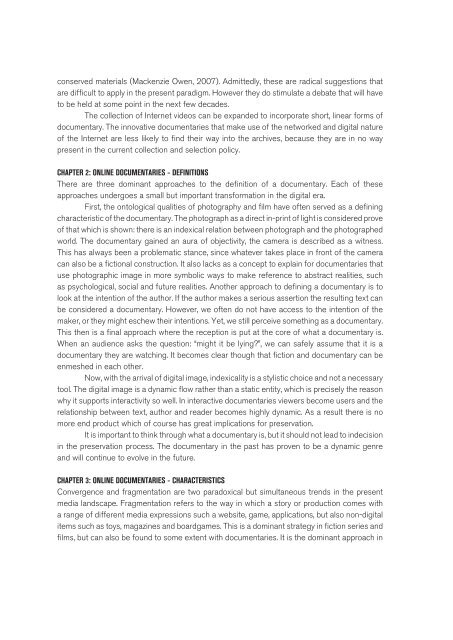Huidige selectiecriteria en de online documentaire HOOFDSTUK 4 ...
Huidige selectiecriteria en de online documentaire HOOFDSTUK 4 ...
Huidige selectiecriteria en de online documentaire HOOFDSTUK 4 ...
Create successful ePaper yourself
Turn your PDF publications into a flip-book with our unique Google optimized e-Paper software.
conserved materials (Mack<strong>en</strong>zie Ow<strong>en</strong>, 2007). Admittedly, these are radical suggestions that<br />
are difficult to apply in the pres<strong>en</strong>t paradigm. However they do stimulate a <strong>de</strong>bate that will have<br />
to be held at some point in the next few <strong>de</strong>ca<strong>de</strong>s.<br />
The collection of Internet vi<strong>de</strong>os can be expan<strong>de</strong>d to incorporate short, linear forms of<br />
docum<strong>en</strong>tary. The innovative docum<strong>en</strong>taries that make use of the networked and digital nature<br />
of the Internet are less likely to find their way into the archives, because they are in no way<br />
pres<strong>en</strong>t in the curr<strong>en</strong>t collection and selection policy.<br />
CHAPTER 2: ONLINE DOCUMENTARIES - DEFINITIONS<br />
There are three dominant approaches to the <strong>de</strong>finition of a docum<strong>en</strong>tary. Each of these<br />
approaches un<strong>de</strong>rgoes a small but important transformation in the digital era.<br />
First, the ontological qualities of photography and film have oft<strong>en</strong> served as a <strong>de</strong>fining<br />
characteristic of the docum<strong>en</strong>tary. The photograph as a direct in-print of light is consi<strong>de</strong>red prove<br />
of that which is shown: there is an in<strong>de</strong>xical relation betwe<strong>en</strong> photograph and the photographed<br />
world. The docum<strong>en</strong>tary gained an aura of objectivity, the camera is <strong>de</strong>scribed as a witness.<br />
This has always be<strong>en</strong> a problematic stance, since whatever takes place in front of the camera<br />
can also be a fictional construction. It also lacks as a concept to explain for docum<strong>en</strong>taries that<br />
use photographic image in more symbolic ways to make refer<strong>en</strong>ce to abstract realities, such<br />
as psychological, social and future realities. Another approach to <strong>de</strong>fining a docum<strong>en</strong>tary is to<br />
look at the int<strong>en</strong>tion of the author. If the author makes a serious assertion the resulting text can<br />
be consi<strong>de</strong>red a docum<strong>en</strong>tary. However, we oft<strong>en</strong> do not have access to the int<strong>en</strong>tion of the<br />
maker, or they might eschew their int<strong>en</strong>tions. Yet, we still perceive something as a docum<strong>en</strong>tary.<br />
This th<strong>en</strong> is a final approach where the reception is put at the core of what a docum<strong>en</strong>tary is.<br />
Wh<strong>en</strong> an audi<strong>en</strong>ce asks the question: “might it be lying?”, we can safely assume that it is a<br />
docum<strong>en</strong>tary they are watching. It becomes clear though that fiction and docum<strong>en</strong>tary can be<br />
<strong>en</strong>meshed in each other.<br />
Now, with the arrival of digital image, in<strong>de</strong>xicality is a stylistic choice and not a necessary<br />
tool. The digital image is a dynamic flow rather than a static <strong>en</strong>tity, which is precisely the reason<br />
why it supports interactivity so well. In interactive docum<strong>en</strong>taries viewers become users and the<br />
relationship betwe<strong>en</strong> text, author and rea<strong>de</strong>r becomes highly dynamic. As a result there is no<br />
more <strong>en</strong>d product which of course has great implications for preservation.<br />
It is important to think through what a docum<strong>en</strong>tary is, but it should not lead to in<strong>de</strong>cision<br />
in the preservation process. The docum<strong>en</strong>tary in the past has prov<strong>en</strong> to be a dynamic g<strong>en</strong>re<br />
and will continue to evolve in the future.<br />
CHAPTER 3: ONLINE DOCUMENTARIES - CHARACTERISTICS<br />
Converg<strong>en</strong>ce and fragm<strong>en</strong>tation are two paradoxical but simultaneous tr<strong>en</strong>ds in the pres<strong>en</strong>t<br />
media landscape. Fragm<strong>en</strong>tation refers to the way in which a story or production comes with<br />
a range of differ<strong>en</strong>t media expressions such a website, game, applications, but also non-digital<br />
items such as toys, magazines and boardgames. This is a dominant strategy in fiction series and<br />
films, but can also be found to some ext<strong>en</strong>t with docum<strong>en</strong>taries. It is the dominant approach in


